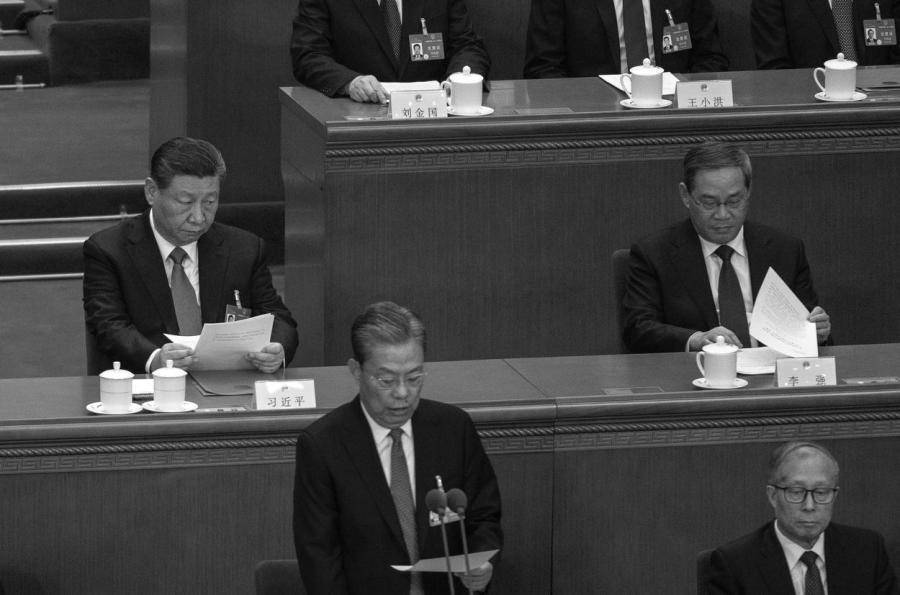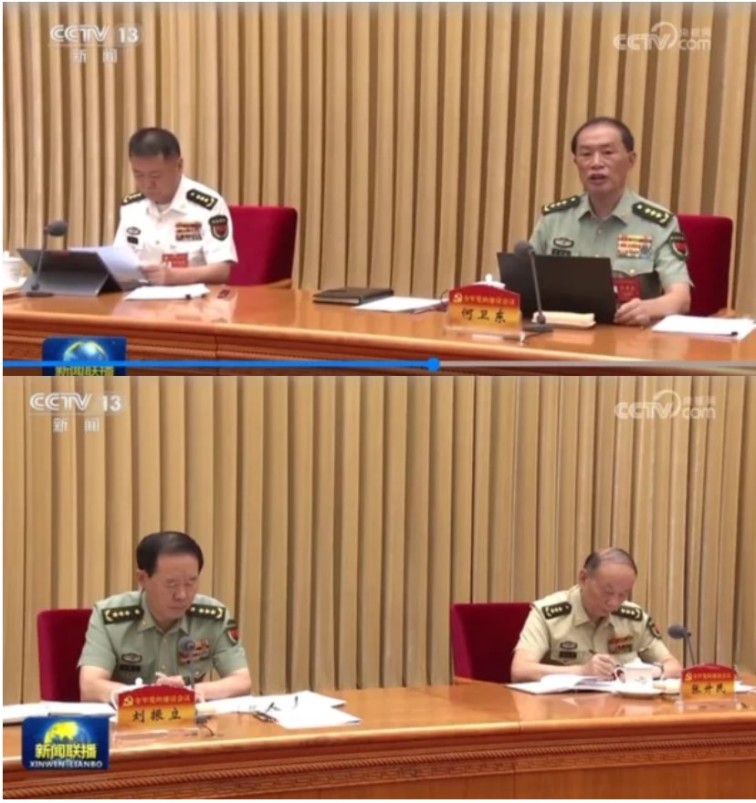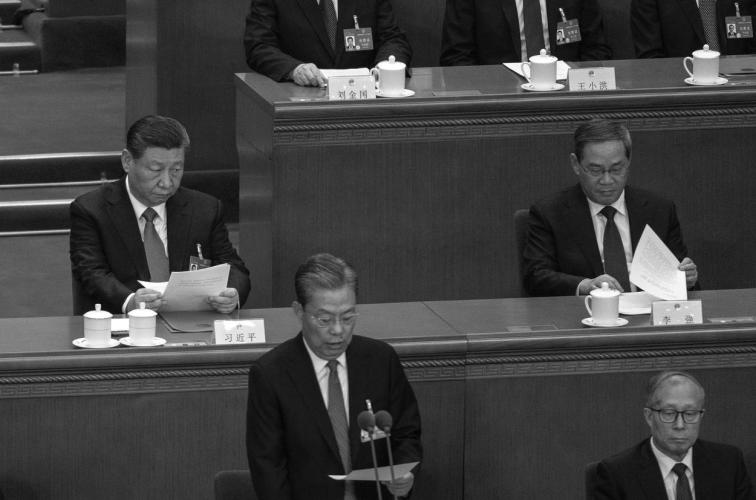File photo: Chinese Communist Party leader Xi Jinping and Premier Li Qiang (right) at the closing meeting of the National People's Congress in the Great Hall of the People. (Photo by Kevin Frayer/Getty Images)
[People News] According to the Chinese Communist Party’s (CCP) official media Xinhua News Agency, the Politburo of the CCP Central Committee held a meeting on April 25 to analyse the current economic situation and economic work. Xi Jinping presided over the meeting.
Xinhua’s report first praised the economy for “showing signs of improvement and a continued boost in social confidence,” but quickly changed tone, stating that the economy still needed stabilisation due to “increased external shocks. It is necessary to strengthen bottom-line thinking, prepare contingency plans, and solidly carry out economic work.”
So, how exactly should economic work be carried out? The meeting proposed to “coordinate domestic economic work and international economic and trade struggle.” This phrase—“international economic and trade struggle”—seems to be a new invention of the CCP, as if reviving the Cultural Revolution to be exported globally.
At the same time, from April 24–25, China’s Ministry of Commerce held the 2025 National Trade Friction Response Work Conference in Beijing. The meeting pointed out that “China’s trade frictions have entered a high-intensity phase. Faced with difficulties and challenges, we must stay confident, maintain composure, employ strategic thinking, seek new opportunities in crises, and open up new prospects amid changing situations. We must raise our political stance, embrace a systems-thinking mindset, and enhance bottom-line and extreme thinking.”
“International economic and trade struggle,” “2025 National Trade Friction Response Work Conference”—these kinds of meetings and Party language might sound novel at first, but on second glance are jarring, and on third, deeply alarming. It smells like the momentum for a second Korean War—a new round of explicit anti-American positioning. It suggests that the days of ordinary Chinese people surviving by “eating grass” may really be approaching.
From the early days of the 14th Five-Year Plan, economic work emphasised balancing domestic and international dual circulation. Then came the "internal circulation" before Trump’s Tariff War 2.0. And now, just a few weeks into the tariff battle, the phrase has shifted again to “coordinating domestic economic work and international economic and trade struggle.” The narrative has flipped too fast, like opening a blind mystery box. This implies that the CCP is preparing for a protracted trade war with Trump, a fight to the death.
Looking at internal propaganda in mainland China, the CCP is eager to give itself face. Headlines proclaim “overseas orders actually increased after losing U.S. orders,” “America lost this round,” and “the dollar is collapsing,” as if China has already won the trade war by lying down.
But in truth, the CCP is only winning with words. In reality, the economy is in shambles, and livelihoods are suffering.
In electronics manufacturing, tariffs of up to 245% have caused a sharp drop in orders. Factories have halted production or even shut down. In textiles and apparel, many U.S.-bound orders were cancelled, leading to severe inventory buildup, production stagnation, and rising unemployment. In home appliance manufacturing, companies like Dongguan Dehong Electric had to suspend orders and shut down due to tariff pressures. In foreign trade logistics and transportation, reduced export orders caused cargo returns, declining demand, job losses for drivers, and a disrupted logistics chain.
The CCP says it can pivot exports to the domestic market, but that’s a false proposition. During the 2018 U.S.-China trade war, trade volume fell 14%, and retail consumption dropped nearly 1%. In 2024, China’s trade surplus with the U.S. was $300 billion, and possibly double that when including re-exports. All of that could now be hit with excess tariffs, far more severe than in 2018. Expecting strong retail numbers is pure fantasy.
Furthermore, in the past seven years, China’s real estate bubble burst, and local government finances, previously propped up by land sales, have collapsed. Add three years of COVID lockdowns, and the middle class has slipped back into poverty. Both government and household spending have hit ceilings. Stimulating domestic demand is easier said than done. The government might resort to subsidies, but it’s already deep in debt. Issuing bonds to increase the fiscal deficit can only go so far. Once subsidies end, everything collapses again.
Notably, China’s export reliance on the U.S. is concentrated in developed coastal provinces—Guangdong, Zhejiang, and Jiangsu. These three provinces are benchmarks of an export-oriented economy, each with over $80 billion in exports to the U.S.: $133.35 billion, $88.76 billion, and $82.96 billion, respectively. Combined, they account for 58.1% of China’s U.S.-bound exports. They also rank among the top provinces for consumer spending. If exports collapse, so do growth and consumption.
Thus, the regions most vulnerable to tariff shocks are China’s economically advanced, export-driven coastal areas—particularly the Yangtze River Delta (Shanghai, Jiangsu, Zhejiang) and Pearl River Delta (Guangdong, Shenzhen, Dongguan). These areas have high trade dependency, are hubs for export manufacturing, and are facing massive risks from U.S. tariffs—order cancellations, production halts, and closures. For instance, in Q1 2025, Guangdong’s GDP grew only 4.1%, below the national average of 5.4% and the province’s 5.5% annual target.
If the trade war escalates, a hard economic decoupling is inevitable, with huge spillover risks. Financial and technological warfare will follow. Trump and his advisors are already considering delisting Chinese concept stocks—a disaster for giants like Pinduoduo, JD.com, and Alibaba. The White House has banned Nvidia’s H20 AI chips from export to China, a major blow to Xi’s pet AI industry DeepSeek. Recently, the U.S. Department of Homeland Security revoked the visas of nearly 100 Chinese students. Trump’s youngest son has even suggested expelling all Chinese students. Talent is core to a tech war, and that pipeline is being choked off.
Despite all this, Xi Jinping still insists on hard confrontation with the U.S.—an act of overestimating himself. It reflects his ongoing misjudgment of both international and domestic political and economic realities. Xi believes the U.S. is in decline due to manufacturing losses and COVID, and that China can now replace the U.S. as a global leader. This is a fatal error.
Xi has also badly misread China’s economic situation. Overemphasis on “self-reliance” and suppression of private enterprise has slowed growth. Small businesses are squeezed, debt risks are rising, and millions are affected. Xi overestimates state-owned enterprise competitiveness and places too much hope on sectors like EVs and AI, while also over-relying on Party control and state intervention to boost the economy. This led to a major economic downturn, collapsed real estate, sluggish consumption, and trade war-fueled export disruptions. The risk of deflation and systemic crisis has increased. Unemployment is high, and public dissatisfaction is growing.
Xi also misjudged China’s global influence. At the start of the trade war, he tried to woo the EU into forming an anti-U.S. alliance, but got nothing. This month, the CCP hosted a so-called regional diplomacy meeting to narrow its “anti-American alliance.” On April 16, Xi visited Vietnam, Singapore, Cambodia, and Malaysia, hoping to unite Southeast Asia against the U.S. But this effort failed. These nations quickly turned their backs. Singapore’s former First Lady, He Jing, mocked Xi twice on social media, calling him a “mob boss,” and said Beijing is under enormous pressure from disrupted exports and supply chain shifts.
India hasn’t gone easy either. During U.S. Senator J.D. Vance’s recent visit, Indian PM Modi welcomed him and announced “major progress” in U.S.-India trade talks, aiming to reduce tariffs. On April 21, the very day of Vance’s visit, India imposed a 12% provisional tariff on certain steel products, targeting China. This shows the U.S. and India are now fully aligned in countering the CCP’s Indo-Pacific strategy.
Xi views compromise as weakness and confrontation as strength. He insists on hardline tactics to maintain CCP leadership status, regardless of the economic and social fallout or the instability it brings. The result of this tariff standoff will be disastrous. It’s like driving off a cliff unknowingly. The entire economic system, under pressure from both external shocks and internal structural problems, is on the brink of collapse, heading toward systemic crisis. Xi Jinping’s struggle with the U.S. is a self-destructive act: cutting off his retreat, walking into his own trap, and tearing down his own wall.
(People News Exclusive)











News magazine bootstrap themes!
I like this themes, fast loading and look profesional
Thank you Carlos!
You're welcome!
Please support me with give positive rating!
Yes Sure!